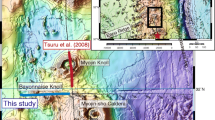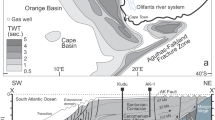Abstract
The Andaman Sea is a back-arc basin that hosts the active Barren and the dormant Narcondam volcanoes. Despite its geological and geophysical significance, there are limited studies conducted over offshore Andaman. Here, a geophysical study of Narcondam offshore is presented to investigate basinal deposits and associated fluids and their migration paths using a 30-km long high-resolution 2D seismic reflection. The migrated section reveals a subsurface image highlighting evidence of a bright seafloor-parallel reflector with negative polarity at a two-way time (TWT) of 2.78–2.82 s (~ 2.2–2.3 km) with an interval velocity of 1.56 km/s. Amplitude versus Angle (AVA) analysis using Aki Richard’s two-term equation is further conducted to characterize the reserved fluid. The AVA analysis yields an increase in amplitude with angle, providing compelling evidence of fluid presence. Additionally, the depth converted migrated seismic section exhibits indications of columnar faults of Neogene period influencing the migration of fluids within the basin.





Similar content being viewed by others
Data availability
The data that support the findings of this study are available from Oil and Natural Gas Corporation Limited.
Code availability
We used academic license of the Echos paradigm and Hampson Russell software.
References
Aleardi M (2018) Applying a probabilistic seismic-petrophysical inversion and two different rock-physics models for reservoir characterization in offshore Nile Delta. J Appl Geophys 148:272–286
Alrefaee HA, Ghosh S, Abdel-Fattah MI (2018) 3D seismic characterization of the polygonal fault systems and its impact on fluid flow migration: an example from the Northern Carnarvon Basin, Australia. J Petrol Sci Eng 167:120–130
Andresen KJ (2012) Fluid flow features in hydrocarbon plumbing systems: what do they tell us about the basin evolution? Mar Geol 332:89–108
Berndt C, Bünz S, Mienert J (2003) Polygonal fault systems on the mid-Norwegian margin: a long-term source for fluid flow. Geol Soc London Special Publ 216(1):283–290
Berndt C, Jacobs C, Evans A, Gay A, Elliott G, Long D, Hitchen K (2012) Kilometre-scale polygonal seabed depressions in the Hatton Basin, NE Atlantic Ocean: constraints on the origin of polygonal faulting. Mar Geol 332:126–133
Biksham G, Subramanian V (1988) Sediment transport of the Godavari River basin and its controlling factors. J Hydrol 101(1–4):275–290
Carlson PR, Golan-Bac M, Karl HA, Kvenvolden KA (1985) Seismic and geochemical evidence for shallow gas in sediment on Navarin continental margin. Bering Sea AAPG Bull 69(3):422–436
Cartwright J (2011) Diagenetically induced shear failure of fine-grained sediments and the development of polygonal fault systems. Mar Pet Geol 28(9):1593–1610
Cartwright JT, Dewhurst DN (1998) Layer-bound compaction faults in fine-grained sediments. Geol Soc Am Bull 110(10):1242–1257
Cartwright JA, Lonergan L (1996) Volumetric contraction during the compaction of mudrocks: a mechanism for the development of regional-scale polygonal fault systems. Basin Res 8(2):183–193
Cartwright J, James D, Bolton A (2003) The genesis of polygonal fault systems: a review. Geol Soc London, Special Publ 216(1):223–243
Cartwright J, Huuse M, Aplin A (2007) Seal Bypass Systems. AAPG Bulletin 91(8):1141–1166
Castagna JP, Swan HW (1997) Principles of AVO crossplotting. Lead Edge 16(4):337–344
Castagna JP, Swan HW, Foster DJ (1998) Framework for AVO gradient and intercept interpretation. Geophysics 63(3):948–956
Curray JR (1989) The Sunda Arc: a model for oblique plate convergence. Neth J Sea Res 24(2–3):131–140
Davies RJ, Mathias SA, Moss J, Hustoft S, Newport L (2012) Hydraulic fractures: how far can they go? Mar Pet Geol 37(1):1–6
Davis AM (1992) Shallow gas: an overview. Cont Shelf Res 12(10):1077–1079
Dewangan P, Ramprasad T, Ramana MV, Mazumdar A, Desa M, Badesab FK (2010) Seabed morphology and gas venting features in the continental slope region of Krishna-Godavari basin, Bay of Bengal: Implications in gas-hydrate exploration. Mar Pet Geol 27(7):1628–1641
Dewangan K, Sinha NN, Sharma PK, Pandey AC, Munichandraiah N, Gajbhiye NS (2011) Synthesis and characterization of single-crystalline α-MoO3 nanofibers for enhanced Li-ion intercalation applications. CrystEngComm 13(3):927–933
Dewangan P, Sriram G, Ramprasad T, Ramana MV, Jaiswal P (2011) Fault system and thermal regime in the vicinity of site NGHP-01-10, Krishna-Godavari basin, Bay of Bengal. Mar Pet Geol 28(10):1899–1914
Fitch TJ (1972) Plate convergence, transcurrent faults, and internal deformation adjacent to southeast Asia and the western Pacific. J Geophys Res 77(23):4432–4460
Foster DJ, Keys RG, Lane FD (2010) Interpretation of AVO anomalies. Geophysics 75(5):75A3-75A13
Frankowicz E, McClay KR (2010) Extensional fault segmentation and linkages, Bonaparte Basin, outer North west shelf, Australia. AAPG Bulletin 94(7):977–1010
Gammaldi S, Ismail A, Zollo A (2022) Fluid accumulation zone by seismic attributes and amplitude versus offset analysis at Solfatara Volcano, Campi Flegrei, Italy. Front Earth Sci 10:866534
Goulty NR (2002) Mechanics of layer-bound polygonal faulting in fine-grained sediments. J Geol Soc 159(3):239–246
Holford SP, Schofield N, Reynolds P (2017) Subsurface fluid flow focused by buried volcanoes in sedimentary basins: evidence from 3D seismic data, Bass Basin, offshore southeastern Australia. Interpretation 5(3):SK39–SK50
Ismail A, Ewida HF, Al-Ibiary MG, Zollo A (2020) Application of AVO attributes for gas channels identification, West offshore Nile Delta Egypt. Pet Res 5(2):112–123
Jackson CAL, Carruthers DT, Mahlo SN, Briggs O (2014) Can polygonal faults help locate deep-water reservoirs? AAPG Bull 98(9):1717–1738
Kallweit RS, Wood LC (1982) The limits of resolution of zero-phase wavelets. Geophysics 47(7):1035–1046
Kim YJ, Cheong S, Chun JH, Cukur D, Kim SP, Kim JK, Kim BY (2020) Identification of shallow gas by seismic data and AVO processing: example from the southwestern continental shelf of the Ulleung Basin, East Sea Korea. Mar Pet Geol 117:104346
Mandler HAF, Clowes RM (1997) Evidence for extensive tabular intrusions in the Precambrian shield of western Canada: A 160-km-long sequence of bright reflections. Geology 25(3):271–274
McCaffrey R (2009) The tectonic framework of the Sumatran subduction zone. Annu Rev Earth Planet Sci 37:345–366
Mishra CK, Dewangan P, Mukhopadhyay R, Banerjee D (2021) Velocity modeling and attribute analysis to understand the gas hydrates and free gas system in the Mannar Basin, India. J Nat Gas Sci Eng 92:104007
Moeremans RE, Singh SC (2015) Fore-arc basin deformation in the Andaman-Nicobar segment of the Sumatra-Andaman subduction zone: Insight from high-resolution seismic reflection data. Tectonics 34(8):1736–1750
Morley CK, Alvey A (2015) Is spreading prolonged, episodic or incipient in the Andaman Sea? Evidence from deepwater sedimentation. J Asian Earth Sci 98:446–456
Mukumoto K, Tsuji T, Hendriyana A (2019) Large gas reservoir along the rift axis of a continental back-arc basin revealed by automated seismic velocity analysis in the Okinawa Trough. Geophys Res Lett 46(16):9583–9590
Nielsen C, Chamot-Rooke N, Rangin C (2004) From partial to full strain partitioning along the Indo-Burmese hyper-oblique subduction. Mar Geol 209(1–4):303–327
Pal T, Mitra SK, Sengupta S, Katari A, Bandopadhyay PC, Bhattacharya AK (2007) Dacite–andesites of Narcondam volcano in the Andaman Sea—an imprint of magma mixing in the inner arc of the Andaman-Java subduction system. J Volcanol Geoth Res 168(1–4):93–113
Ramprasad T, Dewangan P, Ramana MV, Mazumdar A, Karisiddaiah SM, Ramya ER Sriram G (2011) Evidence of slum**/sliding in Krishna–Godavari offshore basin due to gas/fluid movements. Marine and Petroleum Geology 28(10):1806–1816
Rao NP, Kumar MR (1999) Evidences for cessation of Indian plate subduction in the Burmese arc region. Geophys Res Lett 26(20):3149–3152
Rodolfo KS (1969) Sediments of the Andaman basin, northeastern Indian Ocean. Mar Geol 7(5):371–402
Roy TK and Chopra NN (1987) Wrench faulting in Andaman forearc basin, India. In: Offshore technology conference, OTC, pp OTC–5465
Russell BH, Hedlin K, Hilterman FJ, Lines LR (2003) Fluid-property discrimination with AVO: A Biot-Gassmann perspective. Geophysics 68(1):29–39
Sain K, Gupta H (2012) Gas hydrates in India: potential and development. Gondwana Res 22(2):645–657
Schofield N, Holford S, Edwards A, Mark N, Pugliese S (2020) Overpressure transmission through interconnected igneous intrusions. AAPG Bull 104(2):285–303
Shin H, Santamarina JC, Cartwright JA (2010) Displacement field in contraction-driven faults. J Geophys Res: Solid Earth 115:B7
Sieh K, Natawidjaja D (2000) Neotectonics of the Sumatran fault, Indonesia. J Geophys Res: Solid Earth 105(B12):28295–28326
Smith GC, Gidlow PM (1987) Weighted stacking for rock property estimation and detection of gas. Geophys Prospect 35(9):993–1014
Streck MJ, Ramos F, Gillam A, Haldar D, Duncan RA (2011) The intra-oceanic Barren Island and Narcondam arc volcanoes, Andaman Sea: implications for subduction inputs and crustal overprint of a depleted mantle source. Topics in igneous petrology, pp 241–273
Sun Q, Wu S, Lü F, Yuan S (2010) Polygonal faults and their implications for hydrocarbon reservoirs in the southern Qiongdongnan Basin, South China Sea. J Asian Earth Sci 39(5):470–479
Turrini L, Jackson CA, Thompson P (2017) Seal rock deformation by polygonal faulting, offshore Uruguay. Mar Pet Geol 86:892–907
**e X, Li S, He H, Liu X (2003) Seismic evidence for fluid migration pathways from an overpressured system in the South China Sea. Geofluids 3(4):245–253
**ujian DING, Guangdi LIU, Mingliang SUN, Pangen WANG (2013) Origin of polygonal fault systems: a case from the Sanzhao sag in the Songliao Basin East China. Pet Explor Dev 40(3):333–343
Acknowledgements
The authors would like to express their gratitude to ONGC for generously providing us with the datasets used in this research. The availability of these datasets significantly contributed to the success of our study. Additionally, they extend their sincere appreciation to Echos Paradigm, GeoSoftware, and the HRS—AVO module of Hampson Russell software for granting us the academic license, enabling us to utilize their powerful tools in our analysis. Their support played a vital role in achieving the outcomes presented in this paper.
Funding
Funding support and data for the study were facilitated under the “PAN IIT-ONGC” research initiative.
Author information
Authors and Affiliations
Contributions
HKS: methodology, software, writing—original draft, writing and editing. DG: conceptualization, supervision, writing—review and editing.
Corresponding author
Ethics declarations
Ethics approval
Not applicable.
Consent to participate
Not applicable.
Consent for publication
All the authors hereby consent to the publication of the manuscript.
Competing interests
The authors declare no competing interests.
Additional information
Publisher's Note
Springer Nature remains neutral with regard to jurisdictional claims in published maps and institutional affiliations.
Rights and permissions
Springer Nature or its licensor (e.g. a society or other partner) holds exclusive rights to this article under a publishing agreement with the author(s) or other rightsholder(s); author self-archiving of the accepted manuscript version of this article is solely governed by the terms of such publishing agreement and applicable law.
About this article
Cite this article
Srivastav, H.K., Ghosal, D. Investigating Narcondam offshore using high-resolution seismic reflection data. Geo-Mar Lett 43, 18 (2023). https://doi.org/10.1007/s00367-023-00760-3
Received:
Accepted:
Published:
DOI: https://doi.org/10.1007/s00367-023-00760-3




